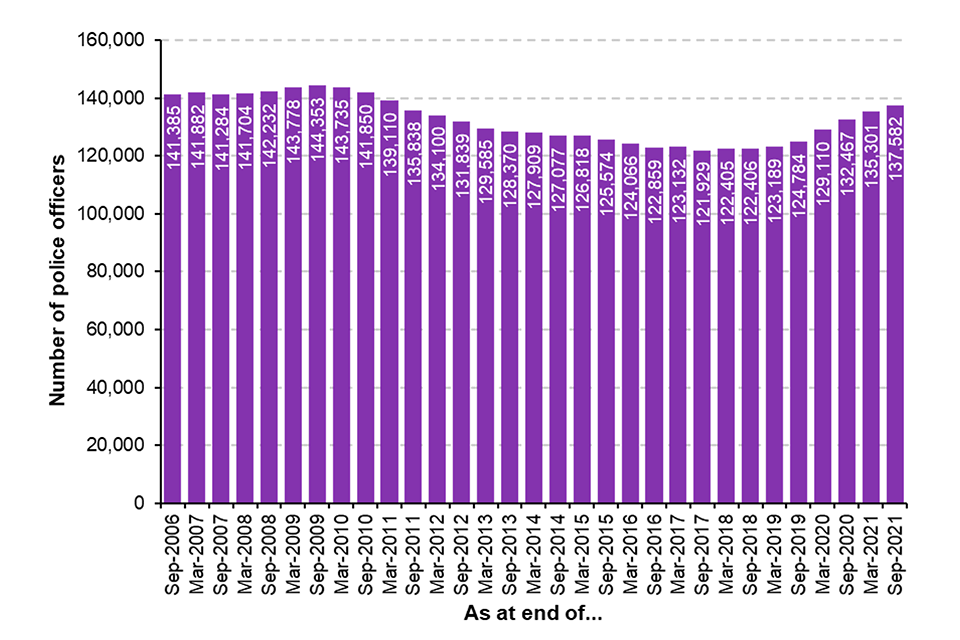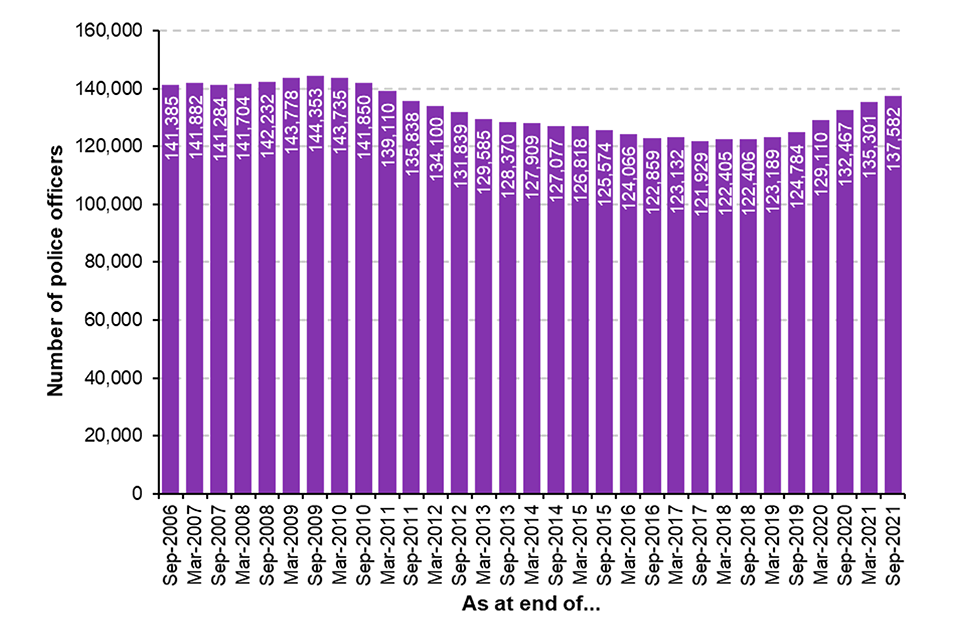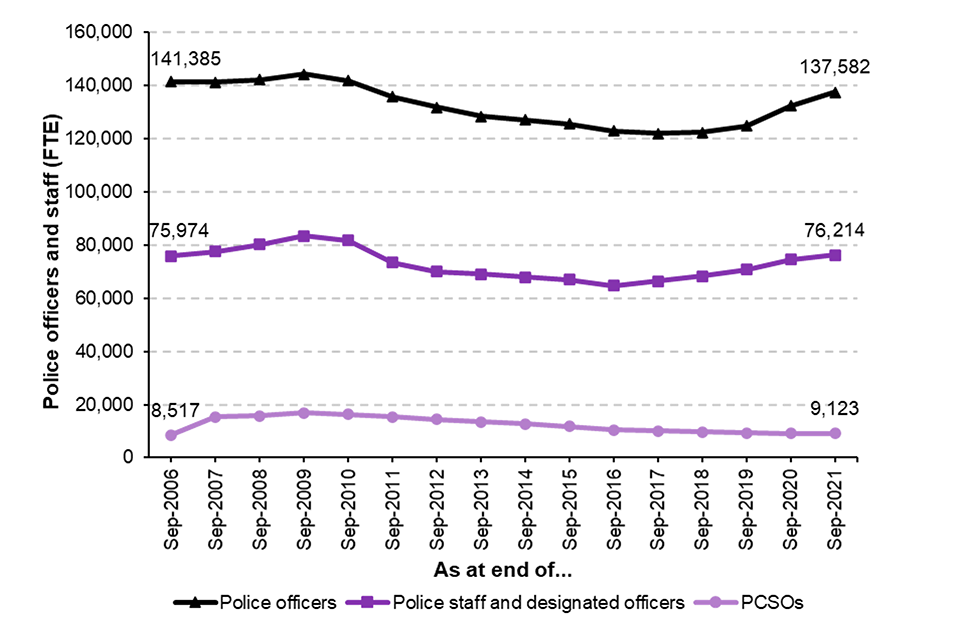Police workforce, England and Wales: 30 September 2021
Published 26 January 2022
Applies to England and Wales
Frequency of release: Biannual
Forthcoming releases: Home Office statistics release calendar
Home Office responsible statistician: Jodie Hargreaves
Press enquiries: pressoffice@homeoffice.gov.uk
Telephone: 0300 123 3535
Public enquiries: crimeandpolicestats@homeoffice.gov.uk
Introduction
This release is a mid-year update of the Police workforce, England and Wales publication series, containing information on police workers (covering both officers and staff) in post on 30 September 2021.
A statistical bulletin on ‘Police officer uplift’ has also been published on the same day. That release provides provisional information on progress with the recruitment of an additional 20,000 police officers in England and Wales as at 31 December 2021. Officer recruited under the uplift programme up to 31 September 2021 are included within totals of full-time equivalent and headcount officers in this statistical bulletin.
Previous releases in this series contained experimental statistics on misconduct and criminal investigations. These data have been designated as Experimental Statistics, to acknowledge that further development is currently taking place to provide more detailed published statistics. Following the introduction of new legislation in February 2020 to overhaul the police discipline system, the Home Office has expanded its data collection from aggregate-level data to individual misconduct case-level data. Due to this improved data collection, the data are undergoing a more in-depth quality assurance exercise and are therefore not included in this release. It is intended that following the completion of this quality assurance exercise, expanded experimental statistics will be published later this year. Information on upcoming statistical publications can be found on the Home Office statistics release calendar.
Key findings
- as at 30 September 2021, the total police workforce size was 222,918 full-time equivalent (FTE), an increase of 3.1% on the previous year
This includes:
- 137,582 FTE police officers
- 76,214 FTE police staff and designated officers
- 9,123 FTE PCSOs
Figure 1: Number of police officers as at 30 September 2006 to 2021, England and Wales

The chart shows that between March 2010 and September 2017, the number of officers in England and Wales was declining. However, there have been increases in officer numbers in each of the 6 months between September 2017 and September 2021. The figure as at September 2021 is 2,281 FTE officers greater than in March 2021.
Recent increases in police officer numbers have been in line with the Government commitment to recruit an additional 20,000 police officers in England and Wales by 31 March 2023, announced in September 2019.
1. Introduction
1.1 General introduction
This release is a mid-year update of the Police workforce, England and Wales publication series. It contains statistics on the numbers of police officers, police staff and designated officers[footnote 1], Police Community Support Officers (PCSOs), special constables and police support volunteers (PSVs) in post on 30 September 2021. The statistics cover all the 43 territorial police forces in England and Wales. Though data for the British Transport Police and the National Crime Agency (NCA) are largely excluded from analysis within this report, their data can be found in the accompanying data tables.
Unless otherwise stated, total workforce figures quoted in the bulletin include those on career breaks or other forms of long term absence, as well as those seconded in to police forces from other forces or central services (e.g. the Home Office, the National Crime Agency). It excludes those seconded out from forces to central services. The headline workforce figures in this release are all presented on a full-time equivalent (FTE) basis unless indicated otherwise. The accompanying data tables provide the same information on a headcount basis.
The User Guide to Police Workforce Statistics contains further information, including a glossary, conventions used, and other background information. It contains further information on the quality and limitations of the various datasets, and the ways in which the Home Office engages with users of the statistics.
1.2 National Statistics Status
The Office for Statistics Regulation (the regulatory arm of the UK Statistics Authority) has confirmed the continued designation of these statistics as National Statistics. This means that these statistics meet the highest standards of trustworthiness, impartiality, quality and public value, and are fully compliant with the Code of Practice for Statistics.
2. Police workforce, as at 30 September 2021
This release is a mid-year update of the Police workforce, England and Wales publication series, containing information on police workers (officers and staff) in post on 30 September 2021 in England and Wales. While this bulletin contains information on all workers as at 30 September 2021, a second statistical bulletin on ‘Police officer uplift’ has also been published on the same day. That release provides provisional information on progress (as at end December 2021) with the recruitment of an additional 20,000 police officers in England and Wales by the end of March 2023.
There were 222,918 workers (FTE) employed by the 43 territorial police forces in England and Wales on 30 September 2021, an increase of 6,728 (or 3.1%) compared with a year earlier, and of 2,399 (1.1%) since March 2021. The size of the workforce has been increasing over the latest two years, from 204,814 as at 30 September 2019, to 216,190 as at 30 September 2020, to 222,918 in the latest figures.
There were increases in both the number of FTE police officers (up 3.9% since 30 September 2020) and police staff and designated officers (up 2.2% over same the period). Meanwhile the number of Police and Community Support Officers remained stable (up 0.1%), whilst the number of special constables fell by 2.5% (on a headcount basis). There was a 3.0% rise in the number (headcount) of police support volunteers (PSVs)[footnote 2].
Table 2.1: Police workforce as at 30 September 2020, 31 March 2021, and 30 September 2021, England and Wales
| 30-Sep-20 | 31-Mar-21 | 30-Sep-21 | Change in 12 months Sep-20 to Sep-21 (number) | Change in 12 months Sep-20 to Sep-21 (%) | |
|---|---|---|---|---|---|
| Police officers | 132,467 | 135,301 | 137,582 | 5,115 | 3.9% |
| Police staff and designated officers | 74,608 | 75,934 | 76,214 | 1,606 | 2.2% |
| PCSOs | 9,115 | 9,284 | 9,123 | 7 | 0.1% |
| Total workforce | 216,190 | 220,519 | 222,918 | 6,728 | 3.1% |
| Special constables (headcount) | 9,126 | 9,174 | 8,901 | -225 | -2.5% |
| PSVs (headcount) | 7,891 | … | 8,129 | 238 | 3.0% |
Source: Workforce data tables
Notes:
- Designated officers and police staff have been combined as some forces are unable to provide data on designated officers separately.
- Special constables and PSVs do not have contracted working hours so their numbers are provided on a headcount basis rather than FTE.
- Durham were unable to provide data on PSVs as at 31 March 2021. Comparisons with March 2021 for England and Wales have therefore been excluded.
2.1 Police officers
As at 30 September 2021, there were 137,582 full-time equivalent (FTE) police officers in the 43 territorial police forces in England and Wales. This was an increase of 1.7% (2,281 officers) since March 2021 (when there were 135,301 officers) and 3.9% from the 132,467 police officers as at 30 September 2020. This is the fourth consecutive year in which an increase on the previous September has been seen, and the second largest September to September increase since comparable records began in 2003. This reflects the ongoing recruitment campaign to recruit an additional 20,000 (headcount) officers by March 2023. Further details on this recruitment drive are available in the ‘Police officer uplift’ statistical series.
In addition to officers working in the 43 territorial police forces, the British Transport Police employed 3,113 full-time equivalent police officers (up from 2,984 in September 2020), and the National Crime Agency (NCA) employed 5,359 FTE officers (up from 4,749 in September 2020). It should be noted that NCA officers are defined on a different basis than the territorial forces and the BTP, since they include both those warranted with the powers of a police constable or other powers, as well as non-warranted officers (civilians involved in the investigation of serious and organised crime). There were also a further 378 police officers seconded out to central services[footnote 3] as at 30 September 2021.
Figure 2.1 shows the long-term trend in police officer numbers in the territorial police forces.
Figure 2.1: Number of police officers as at 30 September 2006 to 2021, England and Wales

Source: Workforce Table 4
Notes:
- Excludes BTP and secondments to central services.
Police officer numbers peaked in September 2009, at 144,353 FTE officers. Between 2009 and 2017 there was a general downward trend, and officer numbers reached a low-point in September 2017. In the last three years the previous downward trend has reversed, and there are now 15,653 (12.8%) more officers than in September 2017. However, the number of officers as at 30 September 2021 remains 6,771 (4.7%) below the peak of 144,353 officers in 2009.
On 5 September 2019 the Prime Minister announced the Government commitment to recruit an additional 20,000 police officers in England and Wales by 31 March 2023. In the years following this announcement (between 30 September 2019 and 30 September 2021), the number of full-time equivalent police officers across the 43 territorial police forces in England and Wales rose by 12,798 (or 10.3%). The increase in the last two years accounts for over 80% of the total increase since the low-point in 2017. Figure 2.2 shows the change in the number of police officers as at 30 March 2007 to 30 September 2021, compared with the previous 6 months.
Figure 2.2: Change in the number of police officers as at 30 March 2007 to 30 September 2021, compared with the previous 6 months, England and Wales

Source: Workforce Table 4
Notes:
- Excludes BTP and secondments to central services.
The statistics in this release show long term trends and comparisons with previous years. It should be noted that percentage changes in the number of police officers cited in this bulletin may differ from those in the companion ‘Police officer uplift’ release. This is because, firstly, the headline measures in this bulletin are based on FTE rather than headcount. Secondly, it is because percentage changes cited in this bulletin are based on all officers employed by forces at a given point in time (e.g. as at 30 September 2021 compared with as at 30 September 2020) whereas those in the ‘Police officer uplift’ series uses an adjusted baseline. Further details on uplift recruitment are available in the ‘Police officer uplift’ bulletin.
2.2 Other worker types
Between September 2020 and September 2021 the number of police staff and designated officers increased by 1,606 (2.2%) from 74,608 FTE to 76,214 FTE. In general, staff and designated officer numbers have followed a similar trend to police officer numbers over the past decade, with falls between 2009 and the low-point in 2016 (64,785 staff and designated officers), before increasing in each year since. In the latest year, PCSO numbers remained stable, increasing slightly by 7 (0.1%) to 9,123 PCSOs. This is the first time since 2009 (when PCSOs peaked at 16,814) in which the number of PCSOs as at 30 September has not fallen when compared with the previous year, as seen in figure 2.3.
Figure 2.3: Number of police officers, police staff and designated officers, and PCSOs, as at 30 September 2006 to 2021, England and Wales

Source: Workforce Table 4
Notes:
- Designated officers and police staff are combined as some forces are unable to provide data on designated officers separately.
Further data, including police officer and staff numbers on a headcount basis can be found in the data tables published alongside these statistics.
-
Designated officers are police staff (who are not police officers) employed to exercise specific powers that would otherwise only be available to police officers ↩
-
Individuals who by choice put their time, experience, knowledge and skills at the disposal of the force without expectation of compensation or financial rewards, except for the payment of pre-determined out of pocket expenses. ↩
-
Secondments to central services are secondments to central government, e.g. the Home Office, HM Inspectorate of Constabulary and Fire & Rescue Services (HMICFRS), or the National Crime Agency (NCA). ↩
